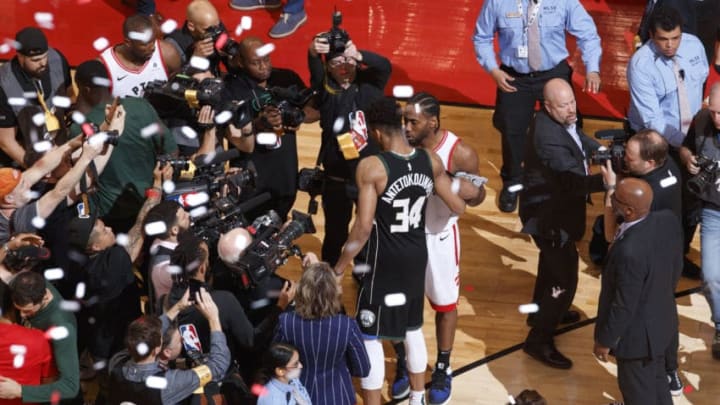
1. What do you think went wrong for Milwaukee on the offensive end, and what do you think they need to improve on going into next season?
Dan Larsen (@DanLarsen34): The Milwaukee Bucks had several issues on the offensive end of the floor in this series, but a few in particular stood out more than others. In fact, they were three specific things that I highlighted as being areas they needed to control in my preview of the series in order to win.
First, Milwaukee were burned by their inability to hit any shots from distance throughout the entire series. Milwaukee shot just 32.9 percent on wide open shots, and were an atrocious 31 percent from three during the series. The Bucks had inconsistent three-point shooting throughout the season, as evidenced by the fact that they were just 16th in three-point percentage during the regular season (35.2 percent).
However, they were never THIS bad over a prolonged stretch of games. The fact that they struggled with these shots threw off their spacing and allowed Toronto to protect the rim as effectively as they did. Had Milwaukee been even close to their regular season percentages, Toronto’s defensive approach would not have succeeded because guys like Pascal Siakam wouldn’t have been able to cheat off of their guy to contest at the rim.
Secondly, their movement on and off the ball was quite poor for significant stretches of games. This limited their ability to create open shots and allowed Toronto’s scheme to go essentially unchallenged. When the movement was good, like it was in the first quarters of Games 5 and 6, the offense was fine because they were creating mismatches and taking advantage of Marc Gasol’s slow foot speed. When it wasn’t, they were unable to generate anything in the half court because Toronto was able to settle into their defensive scheme. Milwaukee could learn a lot from watching Steve Kerr’s ball movement heavy offense from this post-season when Kevin Durant’s been out for Golden State.
One final area where they struggled was controlling the pace. I wrote about the contrast between Toronto and Milwaukee’s pace coming into the series. Toronto had become an extremely slow, grind it out team during the post-season because their offensive efficiency wasn’t as good as their opponents. Milwaukee ended up playing at the pace Toronto wanted throughout the series. Milwaukee went from playing at the fastest pace of any playoff team coming in (103.2), to playing at Toronto’s 12th slowest pace (96.2). This took away the team’s biggest strength (transition offense), and forced them into a half court game where Toronto’s superior creators, like Kawhi Leonard, were always going to have an edge. It also allowed Toronto to settle into their defensive scheme.
Toronto’s defense deserves an immense amount of credit for what they did to the Bucks, but many of Milwaukee’s issues were self-inflicted too.
Theo Konstantellos (@theokon7): First of all, let me start by giving credit to the Toronto Raptors, who are probably the best defense in the NBA. They did a remarkable job of making Giannis uncomfortable throughout the entire series.
However, the Bucks shot a really bad 31 percent from three-point range which certainly did not help open things up for Giannis. And many of the missed shots were wide open. Some could say it was bad luck, some could say it was the Bucks coming up short under pressure but the bottom line is that in 2019 you have to make your three-point shots. It’s as simple as that.
Nikola Mirotic, in particular, was absolutely abysmal as he shot 19.4 percent on a team high 6.2 attempts per game and was benched for the entirety of Game 6 while Eric Bledsoe shot even worse at 17.2 percent which allowed for the Raptors’ defense to cheat off him and help in the paint.
The Bucks started to hesitate a lot because their shots were not falling and this led to stagnation and a slower pace which benefited the Raptors. The Bucks were just taken out of their game.
Jordan Treske (@JordanTreske): I join the chorus to say that the bulk of the Milwaukee’s offensive struggles throughout the Conference Finals came down to their inability to hit wide open shots. Save for a few exceptions such as Malcolm Brogdon and Khris Middleton, the Bucks’ most potent and willing three-point shooters failed to hit shots consistently to alleviate the swarming crowds that Giannis saw frequently throughout the series. That’s where Nikola Mirotic’s growing ineffectiveness as the series wore on especially dinged the Bucks because it left them without one of the more willing and deadly sharpshooters, at least on paper.
It all stems from the Raptors’ defensive gameplan and execution of said gameplan to put the onus on the Bucks’ complementary players to swing the series and it was a formula that eventually led to the Bucks’ demise and ended their season before everyone was ready to see it go.
Adam McGee (@AdamMcGee11): It comes down to Giannis not hitting, or being allowed to hit his peak, plenty of open shots missed, the ball and the players becoming increasingly static, Bledsoe continuing to kill the team’s rhythm in the playoffs, and much more.
The one other thing I’ll highlight is the free throws, though. The offense isn’t faltering when you’re getting to the free throw line. When you fail to take advantage of those easy looks, you’ve only yourself to blame. The Bucks would be playing in the Finals right now if they’d made more free throws.
